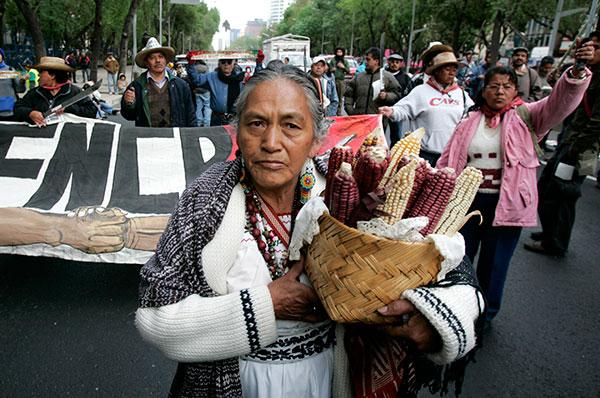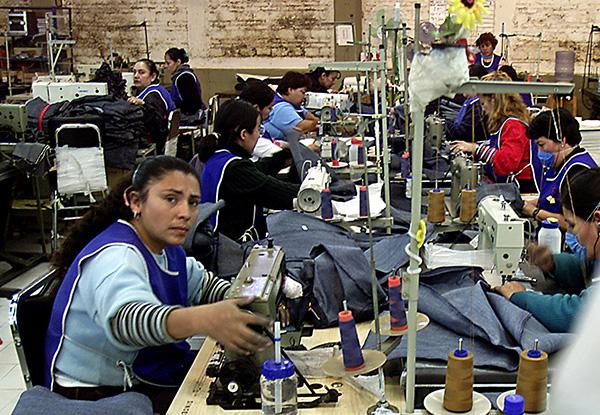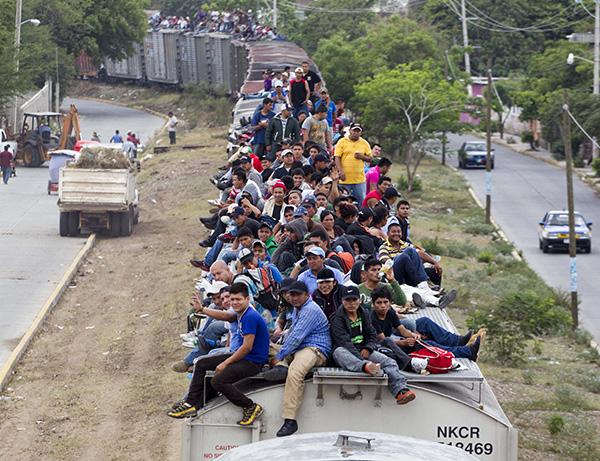Bob Avakian has written that one of three things that has “to happen in order for there to be real and lasting change for the better: People have to fully confront the actual history of this country and its role in the world up to today, and the terrible consequences of this.” (See “3 Things that have to happen in order for there to be real and lasting change for the better.”)
In that light, and in that spirit, “American Crime” is a regular feature of revcom.us. Each installment focuses on one of the 100 worst crimes committed by the U.S. rulers—out of countless bloody crimes they have carried out against people around the world, from the founding of the U.S. to the present day.
See all the articles in this series.


A “free trade” agreement between the U.S., Canada and Mexico known as NAFTA (North American Free Trade Agreement) was implemented in 1994 with much fanfare. In reality, NAFTA was a predatory treaty whose effect was to ratchet up the cruel and reckless plunder of Mexico and its people. But the most damaging effects of NAFTA in Mexico lay in the changes it brought to Mexico’s countryside. There it inflicted vulture-like destruction to millions of small and medium peasant farmers, especially its corn farmers. Here, Mexican farmers protest the end of import protections for their country's corn and bean crops in Mexico City, 2008. (Photo: AP)
The Crime:
A “free trade” agreement between the U.S., Canada, and Mexico, known as NAFTA (North American Free Trade Agreement), was implemented in 1994 with much fanfare. The secretly negotiated 2,000-page treaty was touted as a measure to bring increased prosperity to the people of the three countries. In fact, NAFTA was a predatory treaty whose effect was to ratchet up the cruel and reckless plunder of Mexico and its people.
Under NAFTA, maquiladora factory “sweatshops” along the U.S.-Mexico border expanded dramatically. Within a short time after NAFTA’s ratification, more than 1,000 maquila factories employed a million workers, 75 percent of them women, in oppressive conditions producing cheap goods for U.S. manufacturers at a fraction of the wages paid to U.S. workers.


Under NAFTA, maquiladora factory “sweatshops” along the U.S.-Mexico border expanded dramatically. Here, Mexican women at their sewing machines in a maquiladora sweatshop in Guadalajara, Mexico. (Photo: AP)
Once NAFTA became the law of the land, millions of Mexicans joined the ranks of the hungry. Malnutrition is highest among the country’s farm families, who used to produce enough food to feed the nation. In post-NAFTA Mexico, 42 percent of the food consumed comes from abroad.
Before NAFTA, Mexico spent $1.8 billion on food imports. By 2011, that rose to $24 billion, as Mexico became dependent on imports of rice (80 percent), soybeans (95 percent), beans (33 percent), and wheat (56 percent). Mexico’s thriving dairy sector was devastated under NAFTA, and Mexico became the world’s number one importer of powdered milk, a factor that is linked to a crisis in infant malnutrition.
NAFTA increased the percentage of the population without access to basic food, and the number of Mexican children suffering from malnutrition rose to 20 percent.
Bob Avakian on "Why do people come here from all over the world?"
Bob Avakian on "Why do people come here from all over the world?"
But the most damaging effects of NAFTA in Mexico lay in the changes it brought to Mexico’s countryside. There it inflicted vulture-like destruction to millions of small and medium peasant farmers, especially its corn farmers.
Corn is not only Mexico’s chief crop, it is almost synonymous with Mexico itself, part of an agricultural food system going back to the time long before the European invasion. Mexican farmers are highly skilled agriculturalists who, over time, and through careful selection methods, developed hundreds of varieties of nutritious corn adapted to the soils, climate, and other growing conditions in different parts of the country. These mainly small- and medium-size farms used the resources at hand to maintain soil fertility and healthy crops without resorting to artificial fertilizers or industrial poisons—herbicides and pesticides—common in modern capitalist farms. They were “organic” farmers before the term ever came into use. But in the eyes of NAFTA’s crafters in the U.S. and Mexico, Mexican farmers were backward and an impediment to “progress.”
Prior to NAFTA, and as prelude to it, the government of President Carlos Salinas de Gortari altered Mexico’s revolutionary-era constitution, which had protected peasant communal land known as ejidos. The change allowed these peasant farmlands to be sold, putting them at the mercy of market conditions.
Before NAFTA, Mexican farmers were an exploited population, but there were government subsidies for farmers and tariffs to maintain some price stability and protect farmers’ livelihoods. NAFTA eliminated these tariffs. As originally written and promoted, these tariffs were to be phased out over a 15-year period. But this did not happen. Instead tariffs were eliminated in the span of a few years, opening Mexico’s markets to a flood of cheap U.S. corn. As U.S. corn and other staples poured into Mexico, producer prices dropped as much as 70 percent and small farmers found themselves unable to make a living.
NAFTA’s promoters claimed that subsistence farmers would not be hurt by lowered corn prices since they did not depend on the market. This reflected a total—likely willful—ignorance. Even farmers able to subsist on their own production relied on the sale of corn to purchase products and services they themselves could not produce, like health care. These farmers’ lives were devastated.
At the same time, despite the influx of cheap U.S. corn, consumer food prices actually rose, including the cost of the crucial food staple of the Mexican diet, the tortilla. For example, in 1994 Mexico’s minimum wage (about $4.20 per day) bought 44.9 pounds of tortillas. By 2003 the minimum wage bought only 18.6 pounds.
Since NAFTA, U.S. and other corporations have gobbled up human and natural resources in Mexico on an almost unbelievable scale. Livestock production has moved from small farms for local markets to corporate producers like Tyson, Smithfield, and Pilgrim’s Pride.


In the first years of NAFTA, some 1.3 million Mexicans were forced off their land. The flood of workers into the cities caused a 10 percent fall in industrial wages. Here, migrants ride on top of a north bound train toward the US-Mexico border in Juchitán, southern Mexico. (Photo: AP)
In the first years of NAFTA, some 1.3 million Mexicans were forced off their land. The flood of workers into the cities caused a 10 percent fall in industrial wages. Female-headed households saw their poverty rate increase by 50 percent.
Suicide rates in agricultural states soared as a direct result of NAFTA’s destruction of farm life and the rise in poverty and hunger. The states of Campeche and Tabasco had suicides rates of 9.14 and 9.85 per 100,000 in 2005—almost three times the national average.
With the experience of hunger and malnutrition as an everyday reality and starvation a realistic possibility for themselves and their families, many farmers felt that they had little choice but to leave their farming lifestyle and head north to the U.S.
“Before NAFTA, everybody here grew corn. People didn’t make much money, but nobody went hungry,” according to Griselda Mendoza, 23, sharing common lore from her region of Oaxaca. She was born just after NAFTA was signed. As cheap American corn poured in, it had devastating effects on her family. Her father, Benancio, couldn’t compete. He had to give up and move to the United States for a job. He took up a job as a cook in Tennessee, saving up money to send home so his kids could attend school. “He went north looking for a job and I didn’t see him again for 18 years,” says Mendoza.
The architects of NAFTA actually foresaw the ruinous effects it would have on millions of Mexicans. Testifying before Congress in 1993, before the passage of NAFTA, INS (Immigration and Naturalization Service) commissioner Doris Meissner stated: “Responding to the likely short-to-medium-term impacts of NAFTA, will require strengthening our enforcement efforts along the border both at and between ports of entry.”
“Strengthening enforcement” meant a dramatic increase in militarization of the border, the building of a border wall, and laws criminalizing immigrants that came in measures passed during the administration of Bill Clinton. Deadly conditions created by these repressive laws have lead to thousands of deaths and have kept millions of immigrants from being able to return for visits, effectively cutting them off from their homes and families indefinitely.
The Criminals:
President George H.W. Bush (1989-1993): Began negotiations to include Mexico in the recently signed “free trade” agreement between the U.S. and Canada.
President Bill Clinton (1993-2001): Pushed through the 1994 ratification of NAFTA with the active backing of the U.S. Business Round Table and major corporations and financial groups. Clinton claimed that the treaty would lift people in all countries. But starting in 1994, anticipating an increase in immigrants fleeing from the effects of NAFTA, Clinton’s administration passed several deadly and oppressive measures, Operation Gatekeeper (1994) and the Illegal Immigration Reform and Immigrant Responsibility Act of 1996. Together these measures greatly increased the danger of crossing the Mexico-U.S. border and have led to thousands of deaths, massive deportations, and criminal treatment for millions of immigrants coming north from Mexico and Central America.
Mexico’s President Carlos Salinas de Gortari: Presided over Mexico’s NAFTA negotiations. Under Salinas, a member of the PRI (Partido Revolucionario Institucional) which had ruled Mexico since the late 1920s, the government altered Article 27 of the Mexican constitution to end protections of indigenous communal lands. This change allowed transnational agribusiness “to buy, rent, or enter into association” with communal landholders. This was a stepping stone to NAFTA. Salinas oversaw the privatization of Mexico’s telephone company and banks among a thousand other public entities, some at fire sale prices and to personal friends, and foreign—especially U.S.―capital. Salinas promoted NAFTA with the help of powerful Mexican business interests, claiming it would lift Mexico into the ranks of prosperous “first world” countries. But as his term ended in 1994, Mexico’s economy crashed and Salinas fled the country into exile in a fashion that reminded people of Porfirio Diaz, the infamous Mexican autocrat whose rule gave rise to the Mexican revolution.
The Alibi: Largely negotiated under George H.W. Bush and passed during the presidency of Bill Clinton (after a trade agreement had been negotiated between the U.S. and Canada), NAFTA was touted as a great boon, to the U.S., Canada, and Mexico, benefiting ordinary people in all three countries through more and better jobs and greater prosperity. It was claimed that lifting of trade tariffs would create “a level playing field” allowing wages and living conditions to become more even over time.
The Real Motive:
Creating “a level playing field” and equalizing wages and living conditions was never NAFTA’s intent (nor was it possible under capitalism-imperialism).
After the collapse of the Soviet Union, George H.W. Bush used the phrase “the new world order” to signal U.S.'s intention to reinforce its military, economic, and political dominance in the world. NAFTA can be seen as a key component of this “new world order.”
NAFTA was designed to create a “free trade zone” to meet the challenges of global rivalry from the European Union, Japan, and rising economies in East Asia. The U.S. goal was to combine its financial and technical strength, along with Canada’s, with Mexico’s imperialist-dominated economy and government, and its large population of low-wage workers and poor peasant farmers. By lowering tariffs on imported and exported goods within the North American free trade zone, NAFTA sought to boost the U.S. economy by relocating some U.S. manufacturing to Mexico, where low wages, nonexistent environmental laws, and paltry worker protections gave these companies an advantage in the global game of profit accumulation. Ending tariffs allowed U.S. car manufacturers, for example, to off-shore their parts production and reduce the costs of their cars.
Corn farming in the U.S., unlike in Mexico, is the domain of huge agribusiness conglomerates employing highly capitalized and mechanized industrial farming methods. Under the guiding hand of agricultural monopolies like Cargill and Archer Daniels Midland (ADM), U.S. corn is grown on huge tracts of land using advanced technical methods to bring the cost of corn per unit down. Corn seeds are selected or genetically engineered, not for nutrition or local adaptation but for maximum yield at the lowest cost.
On top of this, U.S. government farm subsidies in 2000 were 10 times greater than the total agricultural budget of Mexico, and the U.S. corn sector is the largest single recipient of U.S. government payments. Thus, huge U.S. agribusinesses had access to U.S. corn surpluses at artificially depressed prices.
All this meant that U.S. corn could be sold at prices well below those possible from Mexico’s small farms. In the words of an Oxfam report on NAFTA: “Far from operating on a ‘level playing field’, small farmers in Chiapas and elsewhere in Mexico are at the wrong end of a steeply sloping playing field which runs downhill from the US Mid-West. They are competing not against US farmers, but against US taxpayers and the world’s most powerful treasury. It is difficult to think of a starker illustration of unfair trade in practice.”
So lowering Mexico’s tariffs on food opened it to more cheaply produced and subsidized U.S. farm products like corn, as well as other U.S. agricultural goods. And this meant potentially huge profits for corporate U.S. growers, eventual control of the food market in Mexico, and the devastation of over a million Mexican farmers just in NAFTA’s first years.
In addition to the destruction of corn farmers, NAFTA opened the floodgates to investment in other areas of Mexican farm production. Much of the investment that arrived went to buying up existing productive capacity, including livestock operations and storage facilities. The absorption of Mexican chicken production by Tyson and Pilgrim’s Pride is an example.
Net exports from the northern part of Mexico grew after NAFTA, but that expansion paled in comparison with new imports of grain, oilseeds, and meat from the United States. After 10 years under NAFTA, Mexico was dependent on the United States for much of its food.
Under NAFTA the millions of small farmers and their families driven off the land were foreseen to become cheap labor in U.S.-owned factories in Mexico and in the fields and other work places in the U.S.
At an AFL-CIO convention in 1997, U.S. President Clinton, citing the challenge to U.S. economic hegemony posed by economic rivals, acknowledged that free trade was “about how 4 percent of the world’s people [the U.S] can continue to hold 20 percent of the world’s wealth.”

Imperialism means huge monopolies and financial institutions controlling the economies and the political systems—and the lives of people—not just in one country but all over the world. Imperialism means parasitic exploiters who oppress hundreds of millions of people and condemn them to untold misery; parasitic financiers who can cause millions to starve just by pressing a computer key and thereby shifting vast amounts of wealth from one place to another. Imperialism means war—war to put down the resistance and rebellion of the oppressed, and war between rival imperialist states—it means the leaders of these states can condemn humanity to unbelievable devastation, perhaps even total annihilation, with the push of a button.
Imperialism is capitalism at the stage where its basic contradictions have been raised to tremendously explosive levels. But imperialism also means that there will be revolution—the oppressed rising up to overthrow their exploiters and tormentors—and that this revolution will be a worldwide struggle to sweep away the global monster, imperialism.
—Bob Avakian, BAsics 1:6
Sources:
Cockcroft, James, Mexico’s Hope. Monthly Review Press 1998
Fanjul, G. and Fraser, A, “Dumping without Borders: How US Agricultural Policies are Destroying the livelihoods of Mexican Corn Farmers.” Oxfam Briefing Paper. Oxfam International, Washington, DC, 2003
Krooth, Richard, Mexico, NAFTA and the Hardships of Progress. McFarland and Co., Inc. No. Carolina, London, 1995
Lopez, Ann, The Farmworkers’ Journey. UC Press, 2007
Nadal, Alejandro, The Environmental & Social Impacts of Economic Liberalization on Corn Production in Mexico. Oxfam, September 2000
Nevins, Joseph, Operation Gatekeeper and Beyond: The War On “Illegals” and the Remaking of the U.S. ‒ Mexico Boundary, 2002, second edition 2010
The World Post, “NAFTA is Starving Mexico,” Lauren Carlsen, director of the Americas Program for the Center for International Policy in Mexico City
Patel, Raj, Stuffed and Starved. Melville House, 2012
